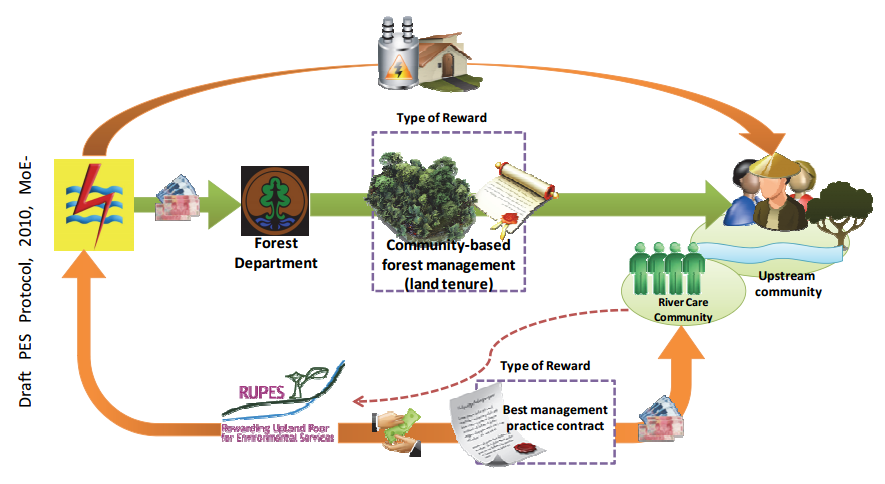概要
Production forests and protected forests can be managed by the community by giving right of individuals over protected forest land. Since 2007, the Indonesian government issued a policy on a Community Forestry Program (HKM) which stated that both production forests and protected forests can be managed by local communities, the public is given the right of individuals over protected forest land as long as the forests are managed with a multi-strata system (planting forests in accordance with elevation levels – from the low, medium to the highest level. Communities are also required to conduct water and soil conservation, and to protect forest areas.
With support from NGOs such as ICRAF (International Center for Research in Agroforestry) and International Fund for Agricultural Development, the concept of PES is introduced through the project RUPJL (Rewarding Upland Poor for Environmental Services They Provide) to communities in the region. RUPJL conceptualizes three proposed reward mechanisms:
– First, payment schemes for environmental services that involve the state electricity company as a purchaser of watershed environmental services.
– Second, the management rights of land as reward mechanisms for watershed protection projects and carbon sequestration. As rewards to providers of environmental services, the Department of Forestry issues permits for public land use. Local communities and governments negotiate legal rights of land use, as a reward for better forest management. ICRAF and local NGOs are to help communities develop the community forestry scheme.
– Third, mechanisms developed to improve the quality of water for domestic use, by introducing the possibility of direct payments.
*Sumber Jaya is a district located in West Lampung Province in which 40% of the area is protected forest area and 10% is national park.
2007年より、政府によりコミュニティ林プログラム(HKM)が発せられ、保護された森林地に対して、個々のコミュニティに利用権を与えることで生産林と保護林はそのコミュニティによって管理されうることが述べられた。民間が多層のシステム(低から中、そして最高レベルへの向上に沿った植林)によって森林を管理する限り、保護林地に対するコミュニティに利用権を与えられたのである。コミュニティにはまた、水および土壌の保全と森林地の保護も求められる。
ICRAF(国際アグロフォレストリー研究センター)のようなNGOや国際農業開発基金の支援のもと、Sumber Jaya地域のコミュニティでは、高地に住む貧困層が環境を保全を行うと報酬金が支払われるシステム(RUPJ)として、「環境サービスに対する支払い制度(PES)」が実施された。RUPJは次の3つの報酬メカニズムを用いている。
第1に、環境サービスへの支払い枠組みの中に、流域の環境サービスの購入者として州の電力会社を巻き込んだ。
第2に、水源保護と二酸化炭素発生抑制(炭素隔離)を行うことに対する報酬として、林業省はコミュニティに土地の利用権を発行している。政府とコミュニティは協定を結び、コミュニティはよりよいコミュニティ林の管理を行い、その報酬として政府より土地利用権が与えられる。ICRAFと地域NGOはコミュニティ林の制度を発展させるためにコミュニティを支援することになっている。
第3に、直接支払の選択肢の導入によって、生活用水の質向上のためのメカニズムが発展した。
Sumber Jayaは、40%が森林保護地で10%が国立公園によって占められるWest Lampung州の1地区である。
パートナーシップのポイント
-An evaluation of PES in Sumber Jaya shows it is quite promising and has good prospects in terms of impact on forest conservation; this is apparent from the increased amount of dense forest, decreased illegal logging, and an increased level of public awareness of the importance of managing forests sustainably;
-To develop monitoring and evaluation mechanisms, both parties were assisted by ICRAF, particularly in setting up criteria and indicators river care programs. The criteria consist of physical, social and economic dimensions;
-ICRAF and local NGOs help communities develop the community forestry scheme;
-The social forestry scheme generally known as “HKM” or “Hkm” (hutan kemasyarakatan) gives farmers land tenure for planting in protected forest. In return, farmers undertake agricultural activities that are more environmentally friendly, and help protect the remaining natural forests, so that forest land will continue to provide a protective benefit to improve the sustainability of the water supply. HKM programs accounted for 70% of the protected forests in Sumberjaya, involving 6,400 farmers and 13,000 hectares of forest area;
-The sources of funds for the hydroelectric power plant are corporate CSR programs, and an environment management fund.
-Sumber Jayaの環境サービスに対する支払制度の評価は、森林保全への影響という観点からして、かなり期待できるものである。多くの森林の密度が増し、違法伐採が減少し、持続可能な森林管理の重要性に対する一般市民の意識向上していることからそう判断できる。
-監視の向上と評価制度を開発するため、特に河川修復プログラムの評価基準と指標づくりを行う場合、政府とコミュニティはICRAFからの支援を受けた。評価基準は、物理的、社会的、経済的な尺度からなる。
-ICRAFと地元のNGOはコミュニティ林制度の発展のためにコミュニティの支援を行う。
-コミュニティ林プログラムでは、政府は農業者に植林用保護林地としていた土地の一部の利用権を与える。その見返りとして、農業者は環境配慮型農業を行いながら残っている自然林の保護を行う。これにより森林は水源となり続け、保全するに値するものとなる。このプログラムは、Sumber Javaの保護林の70%、6400人の農業者と13000haの森林地にあたる。
-この基金の資金源は、水力発電所のCSRと環境管理基金である。
The figure
-Above is a schematic RUPJL in West Lampung. The PES schemes in Sumber Jaya not only involve cash money, but also other forms of support such as a revolving fund for goat farming and fish farming cultivation, the development of micro-hydro installations, and tree seeds. The sources of funds for the hydroelectric power plant are corporate CSR programs. An evaluation of PES in Sumber Jaya shows that this scheme is quite promising in terms of impact on forest conservation; this is apparent from the increased amount of dense forest, decreased illegal logging, and an increased level of public awareness of the importance of managing forests sustainably.
図はWest LampungにおけるRUPJを図示したものである。Sumber Jayaの環境サービスに対する支払い制度のスキームは現金だけでなく、ヤギ牧畜や魚の養殖農業、小水力装置の設置、木々の種子のための資金循環など、他の形でも行われる。
カテゴリー
□Project cooperation/project accord
□事業協力・事業協定
テーマ
□Forest preservation □Biodiversity/nature
□森林保全 □生物多様性・自然保護
主体
Indonesian Ministry of Forestry
インドネシア林業省
Partners
ICRAF and local NGOs
ICRAF(国際アグロフォレストリー研究センター、地元NGO

